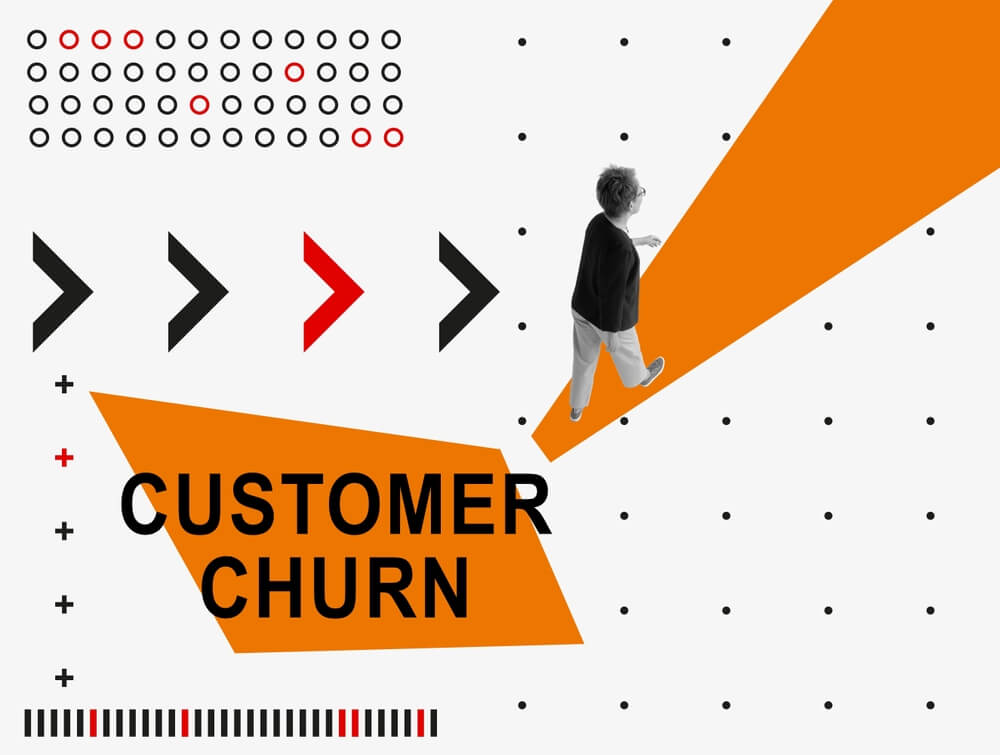
Easy Tips To Reduce SaaS Customer Churn and Build Loyalty
As a software-as-a-service (SaaS) business relying on subscriptions and recurring revenue, managing churn supports scalability and growth. How do you maximize your customer retention?
This article shares five tips a SaaS marketing agency leverages if your revenue hinges on customer retention:
- Leveraging customer feedback
- Enhancing customer onboarding
- Delivering exceptional customer service
- Creating a customer loyalty program
- Continuously improving the product
Read below to learn how to avoid common SaaS killers by minimizing churn and fostering loyalty. Let’s go!
Want to know how we help SaaS businesses stand out from the crowd? Watch this video to learn how DAP makes it happen!
Understanding Customer Churn

In SaaS, customer churn is a critical metric that reflects the rate at which customers cease using a company’s products or services.
The average industry churn rate is 5%, with many goals set below 3%. However, this metric is more complex than it seems–the number depends on the development stage, target audience, and contract terms. Startups could lose up to 15% of their subscribers in the early months after a product launch.
Either way, churn hurts profitability and company valuation because it indicates customer dissatisfaction and reduces the predictability of revenue streams. High churn rates lead to decreased investor confidence and slowdowns in business expansion.
Customer churn in SaaS often stems from a subpar onboarding process, declining product usage, insufficient ongoing customer success strategies, users failing to achieve desired outcomes, a lack of essential features, and pricing concerns.
To avoid these pitfalls, consider these tips:
1. Leverage Customer Feedback
Regular feedback collection through surveys, interviews, and analytics informs you about customer sentiments, pain points, challenges, preferences, expectations, and satisfaction levels. It also:
- Provides valuable insights into areas that require improvement.
- Identifies potential churn triggers before they escalate.
- Determines recurring themes or patterns in feedback data to prioritize initiatives that align with customer priorities
- Enables you to tailor offerings to meet evolving demands effectively.
- It allows you to take actionable steps to drive meaningful product features, user experience, and customer support improvements.
- Demonstrates your commitment to addressing customer concerns and enhancing overall satisfaction.
Proactively responding to feedback signals responsiveness and customer-centric marketing, fostering solid user relationships and loyalty.
2. Enhance Customer Onboarding
Creating a satisfying, convenient onboarding experience is one of the best SaaS customer success strategies. It lays the groundwork for increased user engagement and product adoption.
Develop a seamless user onboarding process, a positive initial interaction, and enhance success with these strategies:
a. Simplify the Onboarding Process
A complex or confusing onboarding process leads to customer frustration. Streamlining it makes it easier for new users to get started with the product. It reduces barriers to adoption, enhances user experience, and increases the likelihood of customers realizing the product’s value early, reducing the churn rate.
b. Provide Educational Resources and Support
Comprehensive educational resources, such as tutorials, guides, webinars, and knowledge bases, help users better understand the product’s features and capabilities. Providing proactive support through chatbots, help centers, and dedicated customer success teams ensures they receive timely assistance.
The knowledge and tools also empower customers. It lets them maximize the product, engage with the brand, become more confident in its value proposition, and reduces churn by increasing customer satisfaction and retention.
c. Personalize the Onboarding Experience for Different Customer Segments
Recognize that different customer segments have unique needs and preferences. Personalize the onboarding experience to decrease churn, enhance the product’s or the brand’s relevance, show your commitment to meeting customer requirements, and create stronger connections with them.
Tailoring onboarding processes, communication strategies, and feature introductions to specific customer segments based on their goals, industry verticals, or usage patterns.
3. Deliver Exceptional Customer Service
Providing exceptional customer service fosters trust, enhances user satisfaction, and strengthens customer loyalty. Effective customer service also significantly influences retention rates by addressing customer concerns promptly, resolving issues efficiently, and creating a positive experience throughout the customer journey.
Become exceptional by:
- Anticipating customer needs and addressing them before they become problems.
- Empowering users with self-service resources, such as knowledge bases and tutorials.
- Engaging with customers through regular communication to provide value-added insights and assistance.
- Responding promptly to customer inquiries and issues to demonstrate attentiveness.
- Providing personalized solutions tailored to individual customer requirements.
- Actively seeking feedback to understand pain points and areas for improvement.
4. Use Automation While Maintaining a Personal Touch
Creating an effective SaaS support delivery system requires delicately balancing automation and personalization. Incorporating automation tools such as AI-driven chatbots and predictive analytics streamlines support processes, reduces response times, and elevates the customer experience.
Automation is crucial in handling repetitive tasks, optimizing workflows, and delivering timely customer assistance. However, maintaining a personalized touch is equally essential.
Tailor responses according to individual customer preferences and history, customize communication to address specific needs and concerns, and integrate human intervention when dealing with complex issues or sensitive matters.
Harmonizing automation with a human touch makes support efficient while preserving the personalized approach that enhances customer satisfaction.
5. Create a Customer Loyalty Program
A SaaS loyalty program employs well-defined strategies to acknowledge and incentivize devoted customers. These initiatives also encourage users to undertake actions that drive revenue and growth. These include repeat purchases, referrals, and regular engagement with the product. They also convert loyal customers into brand advocates.
The best loyalty programs for SaaS include the following:
- Points-based programs let customers earn points for specific actions, such as referrals, purchases, or engagement. They can then redeem the points for rewards such as discounts or upgrades.
- Community programs foster a sense of community among users and encourage interaction and knowledge-sharing, enhancing customer loyalty.
- Referral programs reward customers for referring new users through account credits, extended trials, or access to premium features.
- Usage rewards provide incentives when customers fully adopt the product using a certain number of features or exceeding a usage threshold.
- Tiered programs offer better benefits and discounts to long-standing customers or those on higher payment tiers.
- Personalization rewards give exclusive personalized rewards to loyal users based on their preferences.
- Gamification uses points, badges, and leaderboards to gamify activities and incentivize desired user actions.
- Customer advisory panels select engaged users to provide product feedback and test new features.
- Loyalty discounts offer increasing percentage discounts the longer a customer remains subscribed.
Many SaaS brands succeed in creating a value-based, attractive loyalty program. HubSpot, a platform for inbound marketing and sales, provides a rewards system with tiers based on user activity. By hitting specific milestones, like a set number of contacts or campaigns, users can access more features or receive discounts.
Dropbox’s referral program offers additional storage space for those who refer new users, leveraging existing customers as brand advocates to drive growth.
An expert SaaS marketing agency designs incentives based on specific user actions. Usually, incentives are available for activities that drive value for the business, such as referrals, repeat purchases, or consistent product use. It also tailors rewards and experiences to individual customer preferences and behaviors to enhance engagement and loyalty.
6. Continuously Improve the Product
Reduce the churn rates by developing products that closely match customer needs and expectations. Align them through various methods:
- Continuously researching and gathering feedback from customers
- Monitoring customer behavior and usage patterns
- Collaborating with customers for product development
- Adopting agile methodologies that encourage frequent iterations based on customer input
On the other hand, communicating product updates and new features is essential for keeping customers engaged and informed about the brand’s value. Effective content marketing is one essential strategy. Other strategies for communicating product developments include:
- Email newsletters highlighting new releases and upcoming features
- In-app notifications announcing major updates
- Webinars showcasing new functionalities and answering customer questions
- Blog posts explaining the rationale behind new features and their benefits
In addition, encouraging customer feedback on new releases promotes collaboration and empowers customers to influence product direction.
Some tactics for rewarding customer feedback include public recognition of valuable contributions and early access to beta versions of new features. Consider giving discounts or free trials for sharing constructive criticism and exclusive content or events for active contributors.
Summing Up
Managing churn lies in a comprehensive and strategic approach centered on customer satisfaction and continuous user experience improvement.
This article cites easy strategies to achieve satisfaction. Examples include improving onboarding, implementing ongoing customer success initiatives, addressing feature gaps, and handling pricing concerns. Balancing automation and personalization and creating a well-designed loyalty program further promote customer retention.
If you are searching for a SaaS marketing agency to help you boost customer loyalty, contact Digital Authority Partners (DAP) today to talk with an expert.
Want To Meet Our Expert Team?
Book a meeting directly here




